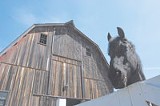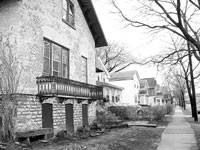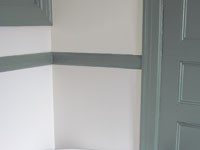[
{
"name": "500x250 Ad",
"insertPoint": "5",
"component": "15667920",
"parentWrapperClass": "",
"requiredCountToDisplay": "1"
}
]
As iconic as the barn is --- it can represent in the American imagination the whole farming lifestyle and economy --- it isn't often recognized for its value as a historic building. Not an office building or a home, where the value is more obvious, or even a school or a factory, where new uses tend to suggest themselves: Barns can fall off the table in architecture-preservation discussions. Sure, they're charming, and no one likes to see a barn slowly falling apart on the landscape. But if a farmer isn't using it anymore, what else should we do with it?
Efforts to recognize the usefulness of barns, and to preserve them, have increased dramatically in recent years. In 1996 Governor Pataki signed the Farmer's Protection and Farm Preservation Act, allowing New York citizens to apply for an income-tax credit equal to 25 percent of the cost of rehabilitating a historic barn (built before 1936). Then in 2000, he unveiled a $2 million Barns Restoration and Preservation Program, grants for capital repairs to agricultural buildings.
In 1997, the New York State Barn Coalition --- a group of government representatives, citizens, and nonprofits --- formed for the sole purpose of looking out for old barns. Its first two objectives: "to encourage local/regional support of farms and agriculture," and "to raise awareness of our barns' value." It also provides educational, economic, and technical help to people trying to restore barns.
Conferences on barn preservation have become more commonplace recently as well. Attendees can learn about grants and other resources, share war stories, and get how-to knowledge. One example is the Landmark Society's upcoming Regional Preservation Conference. This year, for the first time, an entire track is dedicated to historic barns. One session will show how to date barns by using tree-ring patterns in the building's timbers. Another workshop will get into the details of planning and funding a rehab project.
The biggest threat to barns in the Greater Rochester area is a changing economy. "It's principally the declining agricultural base in the state of New York," says Professor Michael Tomlan, Cornell University professor and president of the Barn Coalition. "This state was the one that led the nation in agricultural invention." Now, declining prices and competition with other regions are driving local farmers out of business. (Tomlan names local apple farmers who are competing against the "vast orchards" of the Pacific Northwest as an example.) "The small grower is having a hard time," he says.
Farmland is slowly being lost while suburbs continue to grow. Housing developments and commercial centers are cropping up over and around the fossils that are left behind: You'll find homes in rural-suburban places like Mendon or Scottsville where an old barn --- maybe now used for storage, as a garage, or as a novelty to show off to guests --- comes with the house.
"Structures are best used for the purpose for which they were originally designed," Tomlan says, "though if suburbs can make use of them, that's perfectly fine."
"Because many barns are now located in suburbs where commuters are increasingly concerned about the exercise they are not getting," he adds, "the structures are increasingly serving as mini-health centers, for working out on weight machinery. I am always amused by the size and number of mirrors I encounter."
Some barns even survive, like little pockets of the past, in cities. There are a few in Rochester. In that case, their historic setting is lost, a worry for some preservationists. But the historic character of the building doesn't have to be. Barn advocates are most happy if a barn can be adapted for use as a home or an office without adding tons of windows, breaking up the floor plan, or adding second stories. It should still look like a barn.
Another problem for historic barns is that where farms are still in existence, the old building may not fit the new agricultural model. A barn built 200 years ago needs to be retrofitted to accommodate new livestock housing methods --- electricity, waste removal systems, feeding and ventilation systems --- and the big machinery that is now a part of some types of farming. Tomlan points out that in dairy farming, traditional barns are often set aside because farmers are moving from the barn-silo pairing in favor of other types of storage, more inexpensive pole construction, and metal siding.
But historic barns are remarkably resilient. Part of what gives them their rugged, stoic charm is the fact that many of them were built to last, with strong materials. It takes quite a bit of neglect for all the weathered wood siding, roughhewn logs, plank floors, and dressed beams to completely deteriorate.
"Given that existing structures generally only need a bit of repair," Tomlan says, "replacing them with new structures is simply wasteful."
The Landmark Society will hold its 19th Annual Regional Preservation Conference, "Maintaining Hometown Character in the 21st Century," on Saturday, April 30, at Trinity Episcopal Church, Fall Street, Seneca Falls, 8 a.m. to 3:45 p.m. $40. www.landmarksociety.org, 546-7029 ext 10
In This Guide...
Latest in Preservation
More by Erica Curtis
-
What's in the water?
Jun 14, 2006 -

Roses are red
May 3, 2006 -

A family in circles
Mar 22, 2006 - More »







